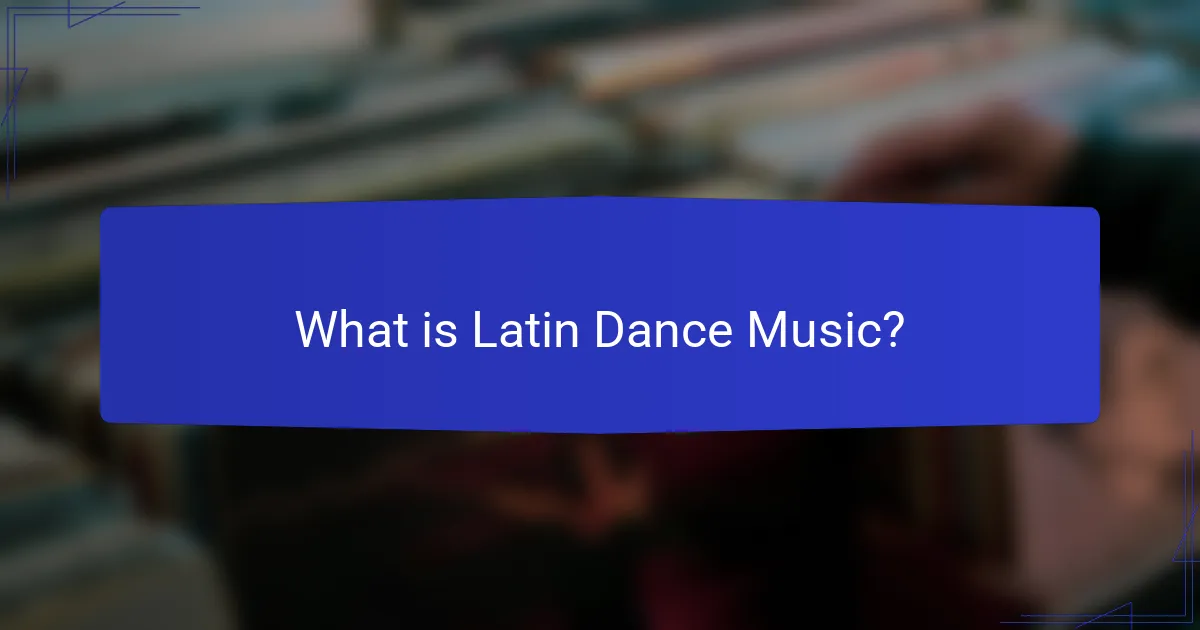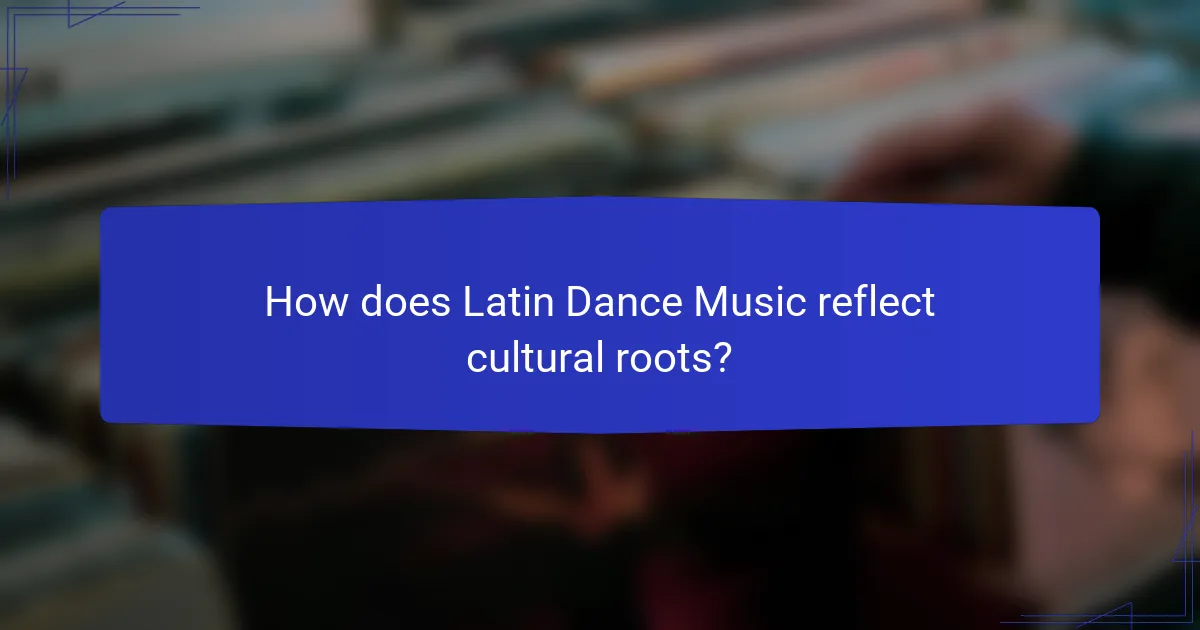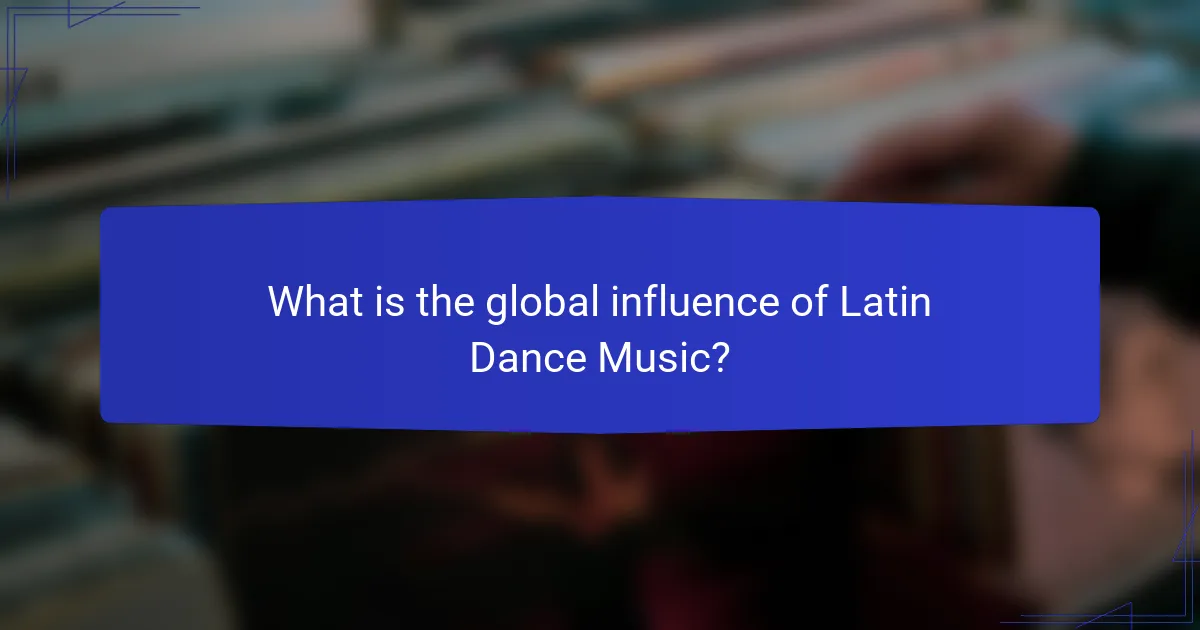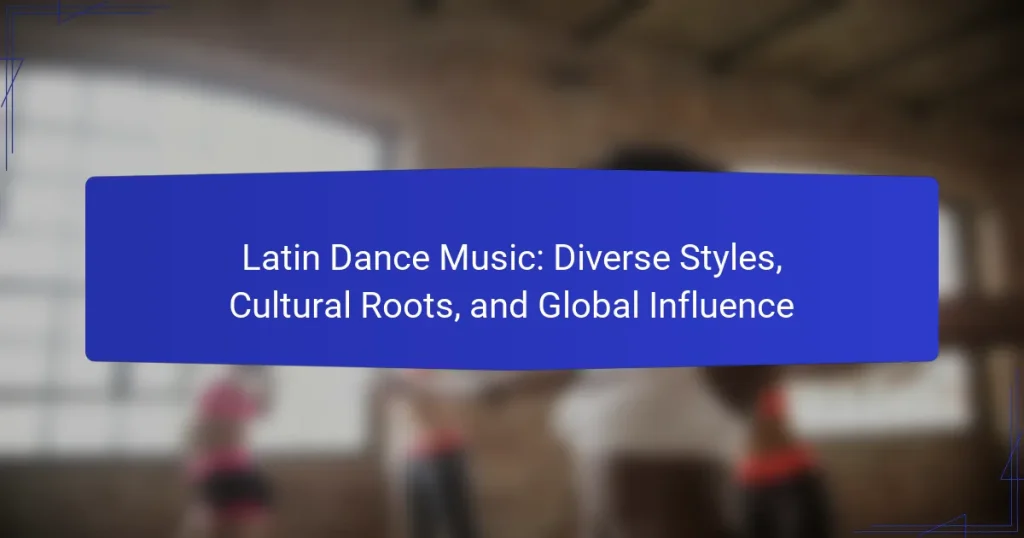Latin Dance Music is a genre that includes various dance-oriented styles originating from Latin American countries, such as salsa, merengue, bachata, and tango. Each style possesses distinct rhythms, melodies, and cultural significance, reflecting a blend of African, Indigenous, and European musical influences. The genre has gained global popularity, influencing music trends and dance styles worldwide, with artists like J Balvin and Bad Bunny leading its mainstream success. Latin Dance Music not only serves as entertainment at social events and competitions but also fosters cultural appreciation and collaboration among diverse musical traditions.

What is Latin Dance Music?
Latin Dance Music is a genre that encompasses various styles of music designed for dancing. This genre includes rhythms and melodies from Latin American countries. Popular forms include salsa, merengue, bachata, and tango. Each style has unique characteristics and cultural significance. Salsa originated in the Caribbean and blends jazz with Afro-Cuban rhythms. Merengue is known for its fast tempo and simple dance steps. Bachata features romantic themes and a slower pace. Tango is characterized by its dramatic and passionate movements. Latin Dance Music has gained global popularity, influencing dance and music worldwide. It is often played at social gatherings, dance clubs, and competitions.
How did Latin Dance Music originate?
Latin Dance Music originated from a blend of various cultural influences, primarily from African, European, and indigenous music traditions. The genre developed in the Caribbean during the late 19th and early 20th centuries. African rhythms and European melodies fused to create distinctive styles. Genres like salsa, merengue, and bachata emerged from this rich musical tapestry. The migration of people across borders facilitated the exchange of musical ideas. Notable historical events, such as the Cuban Revolution, further popularized these dance styles globally. Latin Dance Music continues to evolve, reflecting contemporary influences while honoring its historical roots.
What are the historical influences on Latin Dance Music?
Latin Dance Music is influenced by various historical factors. African rhythms significantly shaped its development. The transatlantic slave trade introduced African musical traditions to Latin America. European colonization brought Spanish and Portuguese musical elements into the mix. The fusion of these diverse influences led to the creation of distinct genres like salsa, merengue, and tango. Additionally, indigenous music contributed unique instruments and melodies. The evolution of Latin Dance Music reflects cultural exchanges over centuries. Social movements and migration patterns also played a role in its transformation. Today, Latin Dance Music continues to evolve, incorporating global influences while retaining its rich heritage.
How have cultural exchanges shaped Latin Dance Music?
Cultural exchanges have significantly shaped Latin Dance Music by integrating diverse musical influences. The blending of African rhythms with European melodies created unique genres. For example, the incorporation of Afro-Cuban elements led to the development of salsa music. Similarly, the influence of jazz introduced improvisation into Latin styles.
In the 20th century, migration patterns facilitated cross-cultural interactions. Cuban musicians brought son and rumba to the United States, influencing jazz and popular music. The global spread of Latin music through media has further diversified its sound. Events like the Latin Grammy Awards highlight this cultural fusion.
Collaborations between Latin artists and musicians from other genres have also enriched the landscape. These exchanges continue to evolve, reflecting contemporary social dynamics. The result is a vibrant and ever-changing musical genre that resonates worldwide.
What are the key characteristics of Latin Dance Music?
Latin Dance Music is characterized by its infectious rhythms, vibrant melodies, and cultural diversity. The music often features syncopated beats that encourage movement and dancing. Instruments such as brass, percussion, and strings are commonly used to create a lively sound. Styles like salsa, bachata, and merengue exemplify the genre’s variety. Latin Dance Music also incorporates elements from African, Spanish, and indigenous music traditions. The tempo usually ranges from moderate to fast, enhancing the energetic atmosphere. Lyrics often reflect themes of love, celebration, and social issues, contributing to its emotional depth. Overall, the genre’s rich cultural roots and global influence make it a dynamic musical form.
What instruments are commonly used in Latin Dance Music?
Common instruments used in Latin Dance Music include the clave, congas, timbales, and maracas. The clave is a fundamental rhythm instrument that establishes the beat. Congas provide a deep, resonant sound essential for many Latin styles. Timbales add sharp, metallic tones that enhance the rhythm. Maracas contribute a distinctive shaking sound, enriching the overall texture. Guitars, especially nylon-string, are also prevalent, adding melodic lines. Horns, such as trumpets and trombones, frequently feature in orchestration, providing vibrant accents. These instruments collectively create the lively and infectious rhythms characteristic of Latin Dance Music.
How do rhythms and melodies define Latin Dance Music?
Rhythms and melodies are fundamental in defining Latin Dance Music. Latin Dance Music features distinct rhythmic patterns that create a lively atmosphere. Common rhythms include the clave, salsa, and bossa nova. These rhythms often involve syncopation, enhancing the danceability of the music. Melodies in Latin Dance Music are typically catchy and repetitive. They often incorporate elements from various cultures, reflecting the genre’s diverse roots. Instruments like congas, timbales, and brass sections add to the unique sound. The interplay of rhythm and melody creates an engaging experience for dancers and listeners alike. This combination fosters a vibrant cultural expression seen in Latin dance forms.
What are the different styles of Latin Dance Music?
Latin dance music encompasses various styles, each with unique rhythms and cultural significance. Salsa is a popular style originating from Cuban and Puerto Rican influences. It features vibrant brass instrumentation and syncopated rhythms. Bachata, hailing from the Dominican Republic, is characterized by its romantic themes and guitar melodies. Merengue, also from the Dominican Republic, has a fast-paced beat and is often accompanied by accordion and percussion. Cumbia, originating from Colombia, blends African, Indigenous, and Spanish influences, known for its distinctive drum patterns. Rumba, a Cuban genre, incorporates complex dance movements and emphasizes improvisation. Each style reflects the rich cultural heritage of Latin America, contributing to the global popularity of Latin dance music.
What are the major genres within Latin Dance Music?
The major genres within Latin Dance Music include Salsa, Merengue, Bachata, and Reggaeton. Salsa originated in the Caribbean and combines elements of jazz and Afro-Cuban rhythms. Merengue is a fast-paced genre from the Dominican Republic characterized by its 2/4 time signature. Bachata has roots in the Dominican Republic and features romantic themes with guitar instrumentation. Reggaeton blends Latin rhythms with hip-hop influences, gaining popularity in the late 1990s. Each genre reflects unique cultural backgrounds and has distinct dance styles associated with it.
How do regional variations influence Latin Dance Music styles?
Regional variations significantly influence Latin Dance Music styles by incorporating local cultural elements and musical traditions. Each region adapts the core rhythms and melodies to reflect its unique heritage. For instance, salsa music from Cuba blends African rhythms with Spanish melodies. In contrast, Brazilian samba emphasizes syncopated rhythms and incorporates indigenous influences. The regional use of instruments also varies; for example, the bandoneón is central to Argentine tango, while the cuatro is vital in Puerto Rican music. These adaptations create distinct sounds that resonate with local audiences. Furthermore, regional dance styles often evolve alongside the music, enhancing the cultural experience. This interplay of music and dance showcases the diversity within Latin Dance Music across different locales.

How does Latin Dance Music reflect cultural roots?
Latin Dance Music reflects cultural roots through its diverse rhythms and instrumentation. It incorporates traditional elements from African, Indigenous, and European musical influences. Genres like salsa and tango showcase these cultural fusions prominently. For example, salsa originated from Cuban son and jazz, blending African rhythms with Spanish melodies. Tango, rooted in Argentina, combines European styles with African influences. The lyrics often express cultural stories and social issues, connecting listeners to their heritage. Furthermore, dance styles associated with this music reflect cultural traditions and communal values. This rich tapestry of sounds and movements illustrates the historical and social contexts of the cultures they represent.
What cultural elements are embedded in Latin Dance Music?
Latin Dance Music incorporates various cultural elements, including rhythms, instruments, and dance styles. The African influence is evident in the complex rhythms and beats. Spanish heritage contributes melodic structures and guitar usage. Indigenous elements manifest through unique instruments like the marimba and charango. Each style, such as salsa and tango, reflects regional cultural practices. Latin Dance Music often serves as a social connector, fostering community and celebration. Its evolution showcases a blend of historical migrations and cultural exchanges. The genre has gained global popularity, influencing music and dance worldwide.
How do traditions and customs influence the music?
Traditions and customs significantly shape music by embedding cultural values and historical narratives. They influence musical styles, rhythms, and instrumentation. For example, African rhythms have deeply impacted Latin music through the transatlantic slave trade. Instruments like the conga and bongo reflect African heritage in Latin dance music. Regional customs also dictate performance practices and social contexts for music. In Cuba, son and salsa integrate Spanish and African elements, showcasing cultural fusion. Festivals and rituals often feature specific musical forms that reinforce community identity. This blend of traditions creates unique sounds that resonate with audiences globally.
What role does dance play in the cultural expression of Latin Music?
Dance is integral to the cultural expression of Latin music. It serves as a physical manifestation of the rhythms and emotions conveyed in the music. Various Latin music genres, such as salsa, tango, and merengue, have specific dance styles associated with them. These dances reflect the cultural heritage and social contexts from which the music originates. For instance, tango originated in the immigrant communities of Buenos Aires in the late 19th century. The dance embodies themes of passion and longing, resonating with the music’s emotional depth. Additionally, dance fosters community connection during social gatherings and celebrations. Events like dance festivals and competitions further promote cultural exchange and appreciation. Overall, dance enhances the experience of Latin music and solidifies its role in cultural identity.
How has Latin Dance Music evolved over time?
Latin Dance Music has evolved significantly over the decades. It began with traditional forms like salsa and merengue in the early 20th century. These styles were deeply rooted in African and Spanish musical influences. In the 1980s, Latin Dance Music saw the rise of genres like Latin pop and reggaeton. This shift introduced electronic elements and new rhythms. By the 2000s, Latin Dance Music gained international popularity, blending with various global genres. Artists like Shakira and Daddy Yankee brought Latin sounds to mainstream audiences. Today, Latin Dance Music continues to evolve, incorporating hip-hop, pop, and EDM influences. The genre’s adaptability contributes to its ongoing relevance in the global music scene.
What trends have emerged in Latin Dance Music in recent years?
Recent years have seen significant trends in Latin Dance Music. The fusion of traditional Latin rhythms with electronic dance music has gained popularity. Artists are increasingly collaborating across genres, blending reggaeton, bachata, and cumbia with pop and hip-hop. Streaming platforms have facilitated global exposure for Latin artists. This has led to a surge in the international audience for Latin Dance Music. Social media challenges and viral dance trends have also amplified its reach. Notable examples include the success of tracks like “Despacito” and “Taki Taki.” These trends highlight the genre’s evolving nature and cultural impact.
How has technology impacted the production of Latin Dance Music?
Technology has significantly transformed the production of Latin Dance Music. Digital audio workstations (DAWs) enable producers to create, mix, and edit tracks efficiently. This has democratized music production, allowing more artists to participate. Sampling technology allows the incorporation of diverse sounds and rhythms from various cultures. MIDI technology facilitates the use of electronic instruments, enhancing creativity. Moreover, online platforms enable global collaboration among artists. Streaming services have changed how music is distributed and consumed. These advancements have led to a broader audience and increased popularity of Latin Dance Music worldwide.

What is the global influence of Latin Dance Music?
Latin Dance Music has a significant global influence, shaping music trends and cultural exchanges worldwide. It blends various genres, including salsa, merengue, bachata, and reggaeton. These styles have gained popularity in numerous countries, transcending cultural boundaries. For instance, reggaeton has become a dominant genre in mainstream pop music. Artists like J Balvin and Bad Bunny have topped international charts. Latin Dance Music also impacts dance styles, inspiring dance trends globally. Events like the World Salsa Summit showcase its widespread appeal. Additionally, Latin music festivals attract audiences from diverse backgrounds, promoting cultural appreciation. The genre fosters collaboration among artists from different musical traditions, enhancing its global reach.
How has Latin Dance Music spread worldwide?
Latin Dance Music has spread worldwide through cultural exchange, media exposure, and global events. The rise of social media platforms has facilitated the sharing of Latin music across borders. Popular genres like salsa, bachata, and reggaeton gained international recognition through artists such as Shakira and Daddy Yankee. Festivals and dance events promote Latin music globally, attracting diverse audiences. Collaborations between Latin artists and mainstream musicians have further enhanced its reach. The incorporation of Latin rhythms in pop and hip-hop music has broadened its appeal. Streaming services have also played a significant role in making Latin Dance Music accessible worldwide. According to the IFPI, Latin music saw a 50% increase in global consumption in 2020 alone.
What are the key markets for Latin Dance Music outside Latin America?
The key markets for Latin Dance Music outside Latin America include the United States, Spain, and the United Kingdom. In the United States, Latin Dance Music has gained significant popularity, particularly in cities with large Hispanic populations, such as Miami and Los Angeles. Spain serves as a crucial market due to its cultural ties and vibrant nightlife scene that embraces Latin rhythms. The United Kingdom has also seen a rise in Latin Dance Music, especially in urban areas like London, where diverse music scenes thrive. According to a report by the Recording Industry Association of America, Latin music sales have grown by over 30% in recent years, highlighting its expanding influence in these markets.
How do collaborations with artists from other genres affect Latin Dance Music?
Collaborations with artists from other genres significantly enhance Latin Dance Music. These partnerships introduce new sounds and styles, broadening the genre’s appeal. For example, collaborations with pop and hip-hop artists often incorporate diverse rhythms and production techniques. This fusion creates innovative tracks that attract wider audiences.
A notable instance is the collaboration between J Balvin and Beyoncé on “Mi Gente.” This track successfully merged reggaeton with pop elements, leading to international chart success. Similarly, the collaboration between Bad Bunny and Cardi B on “I Like It” showcased a blend of trap and salsa, further popularizing Latin Dance Music in mainstream culture.
These collaborations not only expand the genre’s reach but also encourage cultural exchange, promoting Latin music globally. The influence of various genres enriches Latin Dance Music, making it a dynamic and evolving art form.
What impact does Latin Dance Music have on culture and society?
Latin Dance Music significantly influences culture and society by promoting social interaction and community bonding. It serves as a medium for cultural expression and identity among diverse groups. Latin Dance Music has roots in various cultures, including Afro-Caribbean, Spanish, and Indigenous influences. This genre fosters inclusivity and multiculturalism through shared dance experiences. Events centered around Latin Dance Music often attract diverse audiences, encouraging cultural exchange. Additionally, the genre has impacted fashion, language, and lifestyle trends globally. Research indicates that participation in Latin dance can enhance social well-being and mental health. The global popularity of Latin Dance Music, exemplified by the rise of salsa and bachata, reflects its cultural significance and societal impact.
How does Latin Dance Music promote cultural diversity?
Latin Dance Music promotes cultural diversity by blending various musical styles and traditions. It incorporates elements from African, European, and Indigenous music. This fusion creates unique rhythms and melodies that reflect diverse cultural backgrounds. For example, salsa combines Cuban son, jazz, and African rhythms. Similarly, bachata includes influences from Dominican folk music and bolero.
Dance styles associated with these genres also showcase cultural expressions. They often incorporate traditional attire and movements from different cultures. Latin Dance Music fosters collaboration among artists from various backgrounds. This collaboration encourages cultural exchange and understanding. Events like dance festivals further celebrate this diversity. They bring together people from different ethnicities and nationalities.
Overall, Latin Dance Music serves as a platform for cultural appreciation and dialogue. It highlights the rich tapestry of global influences in music and dance.
What social movements are associated with Latin Dance Music?
Latin Dance Music is associated with several social movements, primarily focusing on cultural identity and social justice. The Latinx civil rights movement has utilized this music to express cultural pride and resistance. Additionally, the feminist movement has embraced Latin Dance Music to highlight women’s empowerment within the genre. The [censured] rights movement has also found a voice in this music, promoting inclusivity and acceptance through dance and performance. These movements leverage Latin Dance Music to foster community, celebrate heritage, and advocate for social change.
What are some tips for enjoying and engaging with Latin Dance Music?
To enjoy and engage with Latin Dance Music, immerse yourself in the rhythm and beat. Listen actively to the music, paying attention to the instruments and vocals. Participate in dance classes to learn the movements associated with different styles. Attend live performances to experience the energy of the music firsthand. Explore various genres like salsa, bachata, and merengue to broaden your appreciation. Connect with others who share your interest to enhance your experience. Familiarize yourself with the cultural background of the music for deeper understanding. Use streaming platforms to discover new artists and songs regularly.
How can one learn to dance to Latin Dance Music effectively?
To learn to dance to Latin Dance Music effectively, one should take structured dance classes. Professional instructors can provide guidance on rhythm, footwork, and techniques specific to various Latin styles. Practicing regularly is essential for muscle memory and confidence. Joining social dance events can enhance learning through real-life application. Watching instructional videos can supplement class learning by providing visual examples. Engaging with a dance community fosters motivation and support. Understanding the cultural context of different Latin dances enriches the overall experience. Research shows that consistent practice and social interaction significantly improve dance skills.
What are the best platforms to discover new Latin Dance Music?
The best platforms to discover new Latin Dance Music include Spotify, Apple Music, and YouTube. Spotify offers curated playlists like “Viva Latino,” which features trending Latin tracks. Apple Music provides exclusive releases and playlists that highlight new Latin artists. YouTube is a valuable resource for discovering emerging talents through music videos and live performances. Additionally, SoundCloud allows independent artists to share their work, making it a great platform for finding unique sounds. These platforms collectively enhance the exploration of Latin Dance Music through user-friendly interfaces and extensive music libraries.
Latin Dance Music is a genre that encompasses various styles designed for dancing, originating from Latin American countries. Key styles include salsa, merengue, bachata, and tango, each with unique characteristics and cultural significance. The genre reflects a rich tapestry of cultural exchanges, influenced by African, European, and indigenous musical traditions, and has evolved over time to gain global popularity. This article explores the origins, key characteristics, and instruments of Latin Dance Music, as well as its cultural roots, regional variations, and the impact of technology and collaboration on its evolution. Additionally, it highlights the global influence of Latin Dance Music and its role in promoting cultural diversity and social movements.


